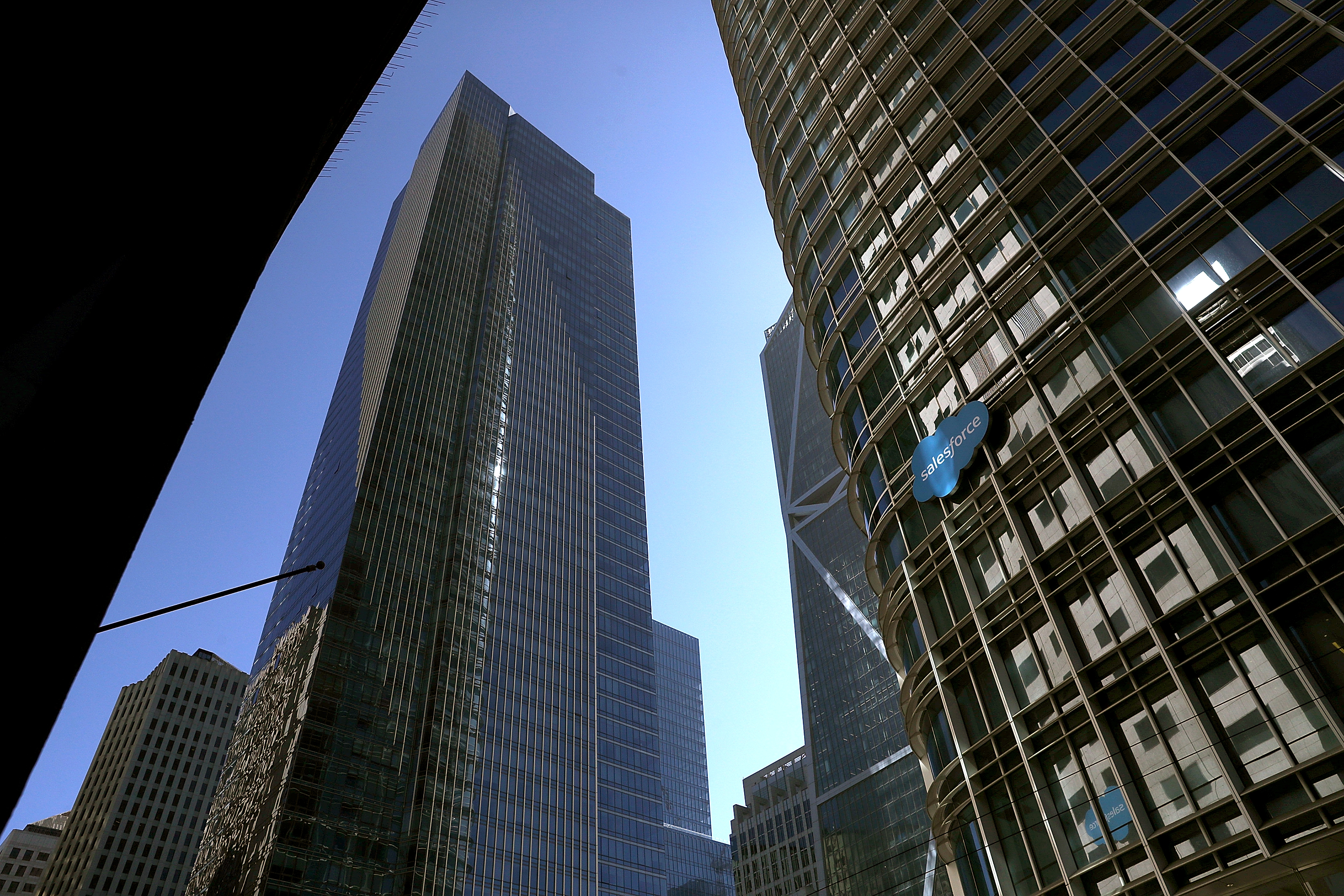San Francisco’s Millennium Tower has been shrouded in controversy for years – but its fate has never looked bleaker than it does today.
Since its opening in 2009, the 58-story skyscraper has sunk 17 inches and tilted another 14 inches to the northwest, causing many residents to speculate about issues with the building’s foundation that could jeopardize their safety.
The structure’s unsteady footing has given rise to a host of other controversies, including weakened home values, accusations of fraud, and years of legal battles. Residents have also complained of mysterious odors, bubbling floors, cracked walls, and a giant fissure in a window on the 36th floor.
But developers have not determined the cause of the tilting and sinking. Though investigators insist the structure is sound, they face mounting apprehension about the building’s future.
Here's a history of everything that's gone wrong with the tower in the past decade.
The $350 million development was proposed in 2002, and construction began three years later.

The building's designer, Handel Architects, is responsible for the World Trade Center Memorial in Lower Manhattan.
At the time of its construction, the tower was the first skyscraper to be built in downtown San Francisco in two decades.
The tower opened to the public in April 2009.

At 58 stories high, the tower is the tallest residential building in San Francisco. Owners of the building's multimillion-dollar luxury condos enjoy panoramic views of the Bay Area and easy access to the city's downtown.
The high-rise is missing its 13th and 44th floors because of superstition among Chinese and American buyers.
In less than five weeks of sales, the tower sold $100 million worth of condos, with units ranging from $1.6 million to $10 million.

The tower's grand penthouse sold for $9.4 million in 2009.
In exchange for a hefty price tag, homeowners gained access to a 20,000-square-foot clubhouse, a temperature-controlled wine locker, and concierge service, among other luxury amenities.
Since its opening, the tower has attracted celebrity tenants such as the former San Francisco 49ers quarterback Joe Montana, the Giants outfielder Hunter Pence, and the venture capitalist Tom Perkins.

All was well until 2010, when construction began on the Salesforce Transit Center (formerly the Transbay Transit Center) next door.

The agency responsible for the transit center, the Transbay Joint Powers Authority, hired a consulting firm to investigate how the excavation could affect the tower.
Its report found that the tower had sunk 10 inches into the ground — 4 inches more than the builders had predicted for the entire lifetime of the structure.

In 2014, a nine-month independent safety review determined that the sinking did not pose a safety risk.

More unsettling news came in 2015, when residents learned that the building had sunk 16 inches and tilted 2 inches to the northwest.

Tenants also complained of cracks in the walls of the parking garage and floors bubbling up from moisture.
The reports kicked off a feud between the tower's developer, Millennium Partners, and the Transbay Joint Powers Authority.

Millennium Partners claims that the construction of the Salesforce Transit Center is responsible for the sinking.

To build the center, the Transbay Joint Powers Authority had to dig a massive hole in the shared land. Developers contend that construction workers pumped too much water out of the ground while the transit center was being built, causing the sand to compress and the tower to sink.
The Transbay Joint Powers Authority, meanwhile, has argued that the tower was built on an unstable foundation.

According to the agency, this caused the sinking long before the transit center moved in next door. It also says the tower's concrete structure should have been anchored to bedrock to support its weight - a conclusion echoed by some homeowners.
In August 2016, residents filed a class-action lawsuit against Millennium Partners, claiming that the developers were aware of the sinking as early as 2008.

Residents are seeking to recover the value of their condos, which have depreciated by an average of $320,000 per unit, SFGate reported, citing the city's assessor. Those attempting to sell have been forced to slash their listing prices or pull their units off the market.
In July 2017, NBC Bay Area described about 50 residents as saying they were "stuck with nearly worthless condos."
Months later, the city attorney, Dennis Herrera, filed a similar suit.

"My office has a duty to protect all the taxpayers of San Francisco," Herrera said at a press conference in November 2016. "We are not going to sit by and allow a developer - or anyone else - to enrich themselves at the expense of others by hiding crucial information."
Hall of Famer Joe Montana also sued the developer in May 2017, seeking a $2.7 million reimbursement for his condo and $1 million in "consequential damages."

Montana and his wife, Jennifer, received a reduced price on their apartment in exchange for promoting the building and allowing their names to be used in marketing material, the lawsuit says.
Their lawsuit names Millennial Partners, the Transbay Joint Powers Authority, and the San Francisco Department of Building Inspection.
In November 2016, the European Space Agency released satellite imagery that it says shows the tower sinking at a rate of 2 inches a year.

Its estimate was double what engineers originally predicted.
In July 2017, a report claimed once again that the building was safe, as residents complained of unexplained odors and openings in the walls.

The report, commissioned by the City of San Francisco, found that the sinking did not have "a significant effect on the building's safety" and did not compromise its ability to resist strong earthquakes.
While some homeowners were comforted by the report, others called it "superficial." The findings, which analyzed the building's condition, were based on a previous report issued by the developer.
To stop the tilting, engineers proposed a renovation costing $200 million to $500 million.

The fix would involve anchoring one side of the building to bedrock - which is more compact and tends to shake less than sand - and allowing the other side to continue sinking until it evened out.
The plan is one of many competing proposals to retrofit the skyscraper. One professor of architectural design even suggested building a second structure next door whose counterweight could stabilize the tower.
In September, an apartment owner detected a large crack in his window on the high-rise's 36th floor.

That same day, residents reported hearing a series of creaking noises, followed by a loud pop. The discovery set off a monthlong investigation, during which the city threatened to "yellow tag" the building, marking it as potentially hazardous to residents.
Around the same time, a drone inspecting the tower hit another building nearby before crashing to the ground.
The investigation ultimately determined that the crack was caused by an "exterior impact," not any sinking or tilting. But the engineering firm hired to inspect the window did not elaborate on what caused the collision.
That same month, the San Francisco Superior Court ruled that the Transbay Joint Powers Authority must pay a portion of Millennium Partners' legal bills.

A 2009 agreement stipulated that the Transbay Joint Powers Authority would protect the developer from "all claims, expenses, and liabilities" related to the shared land. According to the judge, this makes it responsible for two claims filed by the homeowners association, but not any claims related to any attempt by Millennium Partners to defraud homeowners.
The San Francisco Chronicle reported in September that taxpayers could be on the hook for up to $15.7 million in legal fees.

Most of the fees have been used to fend off claims by the developer and homeowners, including hiring witnesses and conducting scientific models, the Chronicle reported.
To date, nine lawsuits have been filed about the tower's tilting and sinking.

Thirty to 40 law firms are involved in the tower's legal disputes. The main case - which involves Millennium Partners, the Transbay Joint Powers Authority, the homeowners association, and individual tenants - is scheduled to go to trial in June 2019.
Melia Robinson contributed reporting.

